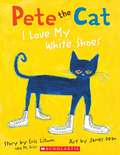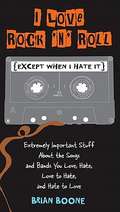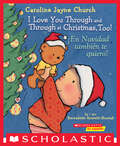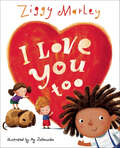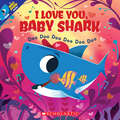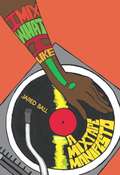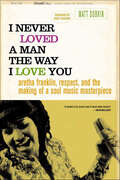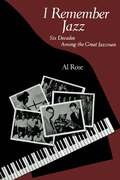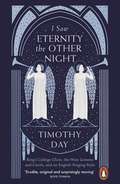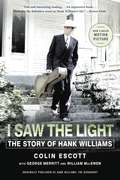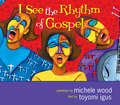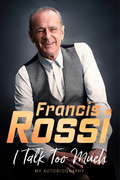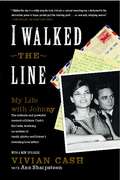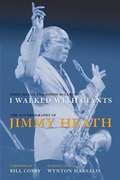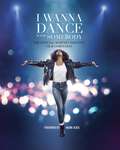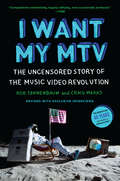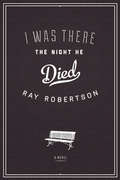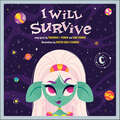- Table View
- List View
I Love My White Shoes (Pete the Cat #1)
by Eric Litwin<p>Don't miss the first and bestselling book in the beloved Pete the Cat series! <p>Pete the Cat goes walking down the street wearing his brand-new white shoes. Along the way, his shoes change from white to red to blue to brown to WET as he steps in piles of strawberries, blueberries, and other big messes! <p>But no matter what color his shoes are, Pete keeps movin' and groovin' and singing his song...because it's all good. Pete the Cat: I Love My White Shoes asks the reader questions about the colors of different foods and objects—kids love to interact with the story. <p>The fun never stops—download the free groovin’ song.</p>
I Love My White Shoes (Pete the Cat)
by Eric Litwin James DeanPete the Cat goes walking down the street wearing his brand new white shoes. Along the way, his shoes change from white to red to blue to brown to WET as he steps in piles of strawberries, blueberries and other big messes! But no matter what color his shoes are are, Pete keeps movin' and groovin' and singing his song... because it's all good.
I Love Rock 'n' Roll (Except When I Hate It)
by Brian BooneMusic breeds duality. We enjoy the music we love-listening to it, talking about it, reading about it. But it's just as fun to passionately revel in mocking the music we hate. Fortunately, musicians make this two-lane path very easy to follow. Half the time they're creating timeless works of art that speak to the soul; the other half, they're recording ridiculous concept albums about robots. I Love Rock 'n' Roll (Except When I Hate It) covers both sides: It celebrates the music world's flashes of genius, the creation of masterpieces, and the little-known stories. . . as well as the entertainingly bad ideas. Armed with a healthy dose of Brian Boone's humorous asides and lively commentary, you'll learn extremely important stuff like: ? How bands got their stupid names ? All alternative rock bands directly descend from Pixies ? The most metal facts of metal in the history of metal ? The secret lives of one-hit wonders ? The story behind "Layla," and other assorted love songs about George Harrison's wife ? What is quite possibly the worst song in rock history Boone also reveals terribly useful information like chart trivia, the rules of music, lists, and many more origins, meanings, and stories about everyone's most loved and loathed musicians.
I Love You More Than You'll Ever Know
by Leslie Odom Jr. Nicolette RobinsonA NEW YORK TIMES BESTSELLERI Love You More Than You'll Ever Know is a touching and heartfelt ode about the way we feel for our children, by award-winning actors of stage and screen Leslie Odom, Jr. and Nicolette Robinson, and illustrated by Joy Hwang Ruiz.Do you remember when we first met?It was a moment I won’t soon forget.Your sparkling aura. Your crooked grin!Do you remember, my trusted friend?When I count all my blessings, you’re always number one.Sweetest of all is, we’ve only just begun.The love we feel for our children never wavers. From the moment a baby is born, through the good times and the bad, from the silly moments to the warm embraces, this love is bigger than what we can put into words.This beautiful book is a comforting and lyrical refrain about the bonds we form with the children to whom we are closest in our lives.
I Love You Through and Through at Christmas, Too! / ¡En Navidad también te quiero! (Bilingual)
by Bernadette Rossetti-ShustakA joyful and loving holiday bilingual board book from the creators of the bestselling I Love You Through and Through!We love our little ones through and through and especially at Christmas, too!Join our bestselling toddler and bear as we huggle and snuggle and wiggle and giggle during this loving holiday.Share some love with your little one with I Love You Through and Through at Christmas, Too!In English and Spanish!Te quiero, yo te quiero... ¡y en Navidad también te quiero!Únete a este pequeñín y a su osito de peluche mientras comparte momentos de ternura con sus hijos. Un libro sobre el amor, en inglés y español, para leer mientras se acurrucan, se abrazan y se ríen juntos durante todo el año... ¡y en Navidad también!
I Love You Too
by Ziggy MarleyBob Marley’s first and most famous son, Ziggy, extends his devotion to youth with his debut children’s book.“A sweetly affectionate ode to togetherness and love.” —Publishers Weekly “Lyrics inspired by an exchange with Marley’s 3-year-old daughter are set to bright paintings of a multicultural cast of children and adults enjoying each other’s company indoors and out . . . The art will draw and hold young children’s attention.” —Kirkus ReviewsReleased simultaneously with Ziggy Marley’s new album, Fly Rasta. A debut children’s book by reggae icon Ziggy Marley with illustrations by Ag Jatkowska. A beautifully illustrated, multicultural children’s picture book based on one of Ziggy Marley’s most beloved songs, I Love You Too. The book explores a child’s relationship with parents, nature, and the unstoppable force of love. This is Ziggy’s first book, though his foray into children’s music is extensive and very well known. He is the singer of Believe in Yourself, the popular theme song of the hit TV show, Arthur. Marley has been a long-time fixture in the children’s entertainment arena. In 2004, he played the role of Ernie, the mischievous jellyfish in the Dreamworks animated smash, Shark Tale, and has made appearances on multiple family and children’s shows including Sesame Street, Dora the Explorer, the 2009 “Macy’s Thanksgiving Day Parade,” and A Family Is a Family Is a Family: A Rosie O’Donnell Celebration on HBO. In 2009, Ziggy, along with his wife, children, and mother Rita Marley, joined President Barack Obama for the 131st annual White House Easter Egg Roll celebration. More recently, he has crafted the theme song for HBO’s Saving My Tomorrow, is featured in the GRAMMY Museum / Cal Science Center’s Exhibit “Saving the Earth with Music” and lent his voice to the PupStar franchise. Marley is also an honorary member of the board of directors for Little Kids Rock, an organization that provides free musical instruments and free lessons to children in public schools throughout the United States. From the introduction by Ziggy Marley: “One day I was in my kitchen making breakfast with my then three-year-old daughter Judah. She looked at me and said, ‘I love you.’ I spontaneously replied to her, ‘I love you too.’ From that came the song and now the book based on the lyrics. I hope you share and enjoy this with your loved ones as I have with mine. I love you too.” *A coproduction of Akashic Books and Tuff Gong Worldwide
I Love You, Baby Shark: Doo Doo Doo Doo Doo Doo (Baby Shark)
by John John BajetSing and dance along with Baby Shark in this story full of kisses, snuggles, and hugs -- the follow-up to the bestselling picture book!How does Baby Shark say "I love you"? No matter where you swim, near or far,My heart will be with you, wherever you are.In the light of day, to the night so dark,I will always love you, Baby Shark!Sing, dance, and read along to this brand-new love-filled song, featuring Baby Shark, Mama Shark, Daddy Shark, and more underwater friends. Perfect for bedtime, Valentine's Day, or any love-filled occasion, Kids and caregivers alike will delight in this silly illustrated story, full of funny, eye-popping illustrations and a catchy tune you won't be able to stop singing. Also features helpful picture guides so readers can dance along, act out the hand and foot movements, and develop their fine motor skills. Snuggle up with your little one and as you laugh, sing, and dance along to this charming and catchy read-aloud!
I Mix What I Like!
by Jared A. BallI Mix What I Like is a study of the hip-hop mixtape as a tool of emancipatory journalism. Looking at colonialism, the media, education, intellectual property, and popular culture Jared Ball examines the ways in which the grassroots history of the rap music mixtape can encourage new forms of political organization and struggle.
I Never Loved a Man the Way I Love You: Aretha Franklin, Respect, and the Making of a Soul Music Masterpiece
by Matt DobkinI Never Loved a Man the Way I Loved You: Aretha Franklin, Respect, and the Making of a Soul Music Masterpiece presents the remarkable story of how The Queen of Soul created what Rolling Stone called “the greatest soul album ever made.”The album she recorded that earned soul legend Aretha Franklin her first major hits after eleven previous efforts, I Never Loved A Man the Way I Loved You was a pop and soul music milestone. Apart from its status as a #1 hit record, the album also had a much wider cultural impact. By early 1967, when the album was released, the Civil Rights Movement was well underway; Aretha’s music gave it its theme song. And the #1 Billboard pop chart single “Respect”—written by Otis Redding—not only won two Grammys for best R&B recording and best R&B solo female vocal performance, it became a passionate call to arms for the burgeoning feminist movement.Matt Dobkin has unearthed a wonderful story of the creation of an album that goes far beyond anything that’s been written about Aretha before. With scores of interviews—including ones with Atlantic Records’ famed producer Jerry Wexler, and the Muscle Shoals session musicians who recorded with Aretha—I Never Loved A Man the Way I Love You is the story of a great artistic achievement. It’s also the story of a star who is both more complex and determined than her modern image as a diva indicates.
I Remember Jazz: Six Decades Among the Great Jazzmen
by Al RoseAl Rose has known virtually every noteworthy jazz musician of this century. For many of them he has organized concerts, composed songs that they later played or sang, and promoted their acts. He has, when called upon, bailed them out of jail, straightened out their finances, stood up for them at their weddings, and eulogized them at their funerals. He has caroused with them in bars and clubs from New Orleans to New York, from Paris to Singapore -- and survived to tell the story. The result has been a lifetime of friendship with some of the music world's most engaging and rambunctious personalities. In I Remember Jazz, Rose draws on this unparallelled experience to recall, through brief but poignant vignettes, the greats and the near-greats of jazz. In a style that is always entertaining, unabashedly idiosyncratic, and frequently irreverent, he writes about Jelly Roll Morton and Bunny Berigan, Eubie Blake and Bobby Hackett, Earl Hines and Louis Armstrong, and more than fifty others.Rose was only twenty-two when he was first introduced to Jelly Roll Morton. He quickly discovered that they had more in common than a love of music. Something of a peacock at that age, Rose was dressed in a "polychromatic, green-striped suit, pink shirt with a detachable white collar, dubonnet tie, buttonhole, and handkerchief" -- and so was Jelly Roll. About Eubie Blake, Rose notes that he was not only a superb musician but also a notorious ladies' man. Rose recalls asking the noted pianist when he was ninety-seven, "How old do you have to be before the sex drive goes?" Blake's reply: "You'll have to ask someone older than me." Once in 1947, Rose was asked to assemble a group of musicians to play at a reception to be hosted by President Truman at Blair House in Washington, D.C. The musicians included Muggsy Spanier, George Brunies, Pee Wee Russell, Pops Foster, and Baby DOdds. But the hit of the evening was President Truman himself, who joined the group on the piano to play "Kansas City Kitty" and the "Missouri Waltz."I Remember Jazz is replete with such amusing and affectionate anecdotes -- vignettes that will delight all fans of the music. Al Rose does indeed remember jazz. And for that we can all be grateful.
I Saw Eternity the Other Night: King's College, Cambridge, and an English Singing Style
by Timothy DayThe sound of the choir of King's College, Cambridge - its voices perfectly blended, its emotions restrained, its impact sublime - has become famous all over the world, and for many, the distillation of a particular kind of Englishness. This is especially so at Christmas time, with the broadcast of the Festival of Nine Lessons and Carols, whose centenary is celebrated this year. How did this small band of men and boys in a famous fenland town in England come to sing in the extraordinary way they did in the twentieth and early twenty-first centuries?It has been widely assumed that the King's style essentially continues an English choral tradition inherited directly from the Middle Ages. In this original and illuminating book, Timothy Day shows that this could hardly be further from the truth. Until the 1930s, the singing at King's was full of high Victorian emotionalism, like that at many other English choral foundations well into the twentieth century.The choir's modern sound was brought about by two intertwined revolutions, one social and one musical. From 1928, singing with the trebles in place of the old lay clerks, the choir was fully made up of choral scholars - college men, reading for a degree. Under two exceptional directors of music - Boris Ord from 1929 and David Willcocks from 1958 - the style was transformed and the choir broadcast and recorded until it became the epitome of English choral singing, setting the benchmark for all other choral foundations either to imitate or to react against. Its style has now been taken over and adapted by classical performers who sing both sacred and secular music in secular settings all over the world with a precision inspired by the King's tradition.I Saw Eternity the Other Night investigates the timbres of voices, the enunciation of words, the use of vibrato. But the singing of all human beings, in whatever style, always reflects in profound and subtle ways their preoccupations and attitudes to life. These are the underlying themes explored by this book.
I Saw The Light: The Story of Hank Williams - Now a major motion picture starring Tom Hiddleston as Hank Williams
by Colin EscottIn his brief life, Hank Williams created one of the defining bodies of American music. Songs like Your Cheatin' Heart, Hey Good Lookin' and Jambalaya sold millions of records and became the model for virtually all country music that followed.But by the time of his death at age twenty-nine, Williams had drunk and drugged and philandered his way through two messy marriages and out of his headline spot on the Grand Ole Opry. Even though he was country music's top seller, toward the end he was so famously unreliable that he was lucky to get a booking in a beer hall.After his death, Williams' records sold more than ever, and have continued to do so in the half-century since. His oft-covered catalog has produced hits for artists ranging from Fats Domino and John Fogerty's Blue Ridge Rangers to Ray Charles and B.J. Thomas; from Bob Dylan and jazz diva Norah Jones, to crooner Perry Como, R&B star Dinah Washington, and British punk band, The The.In this definitive account Colin Escott vividly details the singer's stunning rise and his spectacular decline, and reveals much that was previously unknown or hidden about the life of this country music legend.Now, over sixty years after his death, a major motion picture starring Tom Hiddleston and Elizabeth Olsen brings Hank Williams' tragic story to the screen. I Saw The Light first premiered at the Toronto International Film Festival and will be distributed by Sony Picture Classics in the UK.
I Saw the Light: The Story of Hank Williams
by Colin Escott George Merritt William MacewenThe book that inspired the major motion picture I Saw the Light. Originally published as Hank William: The Biography.In his brief life, Hank Williams created one of the defining bodies of American music. Songs such as "Your Cheatin' Heart," "Hey, Good Lookin'," and "Jambalaya" sold millions of records and became the model for virtually all country music that followed. But by the time of his death at age twenty-nine, Williams had drunk and drugged and philandered his way through two messy marriages and out of his headline spot on the Grand Ole Opry. Even though he was country music's top seller, toward the end he was so famously unreliable that he was lucky to get a booking in a beer hall. Colin Escott's enthralling, definitive biograph--now the basis of the major motion picture I Saw the Light--vividly details the singer's stunning rise and his spectacular decline, revealing much that was previously unknown or hidden about the life of this country music legend.
I See the Rhythm of Gospel
by Michele Wood Toyomi Igus'We free now, baby,' mama whispers as we bounce and sway with the wagon's twists and turns over roads of clay through the land that oppressed us to a new world, a brand new day. The dynamic author/illustrator team of Toyomi Igus and Michele Wood has come together again to produce I See the Rhythm of Gospel, a sequel to the Coretta Scott King Award-winning I See the Rhythm. Readers of all ages will be captivated by this informative and inspirational blend of poetry, art, and music that relates the history of gospel music as reflected through the journey of African Americans from their arrival as slaves in America to the election of our first black president, Barack Obama.
I Talk Too Much: My Autobiography
by Francis RossiTHE SUNDAY TIMES BESTSELLER'THE ROCK 'N' ROLL AUTOBIOGRAPHY OF THE YEAR' MAIL ON SUNDAY'Essential for fans and great reading for anyone else' Classic RockBreak-ups, make-ups, groupies, band politics, court battles, the tragic death of Rick Parfitt . . . This is Francis Rossi as you have never seen him before.Status Quo have sold over 100 million records worldwide, including 65 hit singles and 32 hit albums. The legendary band's career has mirrored the evolution of rock music. From the struggles of the flower-power '60s, the highs of the denim-clad '70s, the coke- and tequila-induced blur of the '80s, to fighting for musical integrity in the '90s and '00s and a fresh lease of life from new band members in recent years, Rossi has been there for the entirety of Quo's turbulent history.In I Talk Too Much, Rossi will reveal the truth behind one of the biggest rock bands of all time, as well as the personal highs and lows of a career spanning over 50 years. He lifts the lid on the man behind the music - from humble beginnings in Forest Hill and being labelled a has-been by the press in his twenties to opening Live Aid in 1985 - and why he's still going strong at seventy. Along the way he has fathered eight children with three mothers and beaten both alcoholism and cocaine addiction. Rossi comes clean about the time he almost left the band, what he really thinks about the music industry today and the complexities of his fifty-year friendship with Rick Parfitt.Painfully honest, riotously funny and frequently outrageous, I Talk Too Much covers the glory years, the dark days and the real stories behind the creation of some of the greatest rock music of all time.
I Talk Too Much: My Autobiography
by Francis RossiTHE SUNDAY TIMES BESTSELLER'THE ROCK 'N' ROLL AUTOBIOGRAPHY OF THE YEAR' MAIL ON SUNDAY'Essential for fans and great reading for anyone else' Classic RockBreak-ups, make-ups, groupies, band politics, court battles, the tragic death of Rick Parfitt . . . This is Francis Rossi as you have never seen him before.Status Quo have sold over 100 million records worldwide, including 65 hit singles and 32 hit albums. The legendary band's career has mirrored the evolution of rock music. From the struggles of the flower-power '60s, the highs of the denim-clad '70s, the coke- and tequila-induced blur of the '80s, to fighting for musical integrity in the '90s and '00s and a fresh lease of life from new band members in recent years, Rossi has been there for the entirety of Quo's turbulent history.In I Talk Too Much, Rossi will reveal the truth behind one of the biggest rock bands of all time, as well as the personal highs and lows of a career spanning over 50 years. He lifts the lid on the man behind the music - from humble beginnings in Forest Hill and being labelled a has-been by the press in his twenties to opening Live Aid in 1985 - and why he's still going strong at seventy. Along the way he has fathered eight children with three mothers and beaten both alcoholism and cocaine addiction. Rossi comes clean about the time he almost left the band, what he really thinks about the music industry today and the complexities of his fifty-year friendship with Rick Parfitt.Painfully honest, riotously funny and frequently outrageous, I Talk Too Much covers the glory years, the dark days and the real stories behind the creation of some of the greatest rock music of all time.
I Thought I Heard You Speak: Women at Factory Records
by Audrey GoldenFactory Records has become the stuff of legend. The histories of the label have been told from many perspectives, from visual catalogues and memoirs to exhibitions. Yet no in-depth history has ever been told from the perspectives of the women who were integral to Factory's cultural significance. The untold history of Factory Records is one of women's work at nearly every turn: recording music, playing live gigs, running the label behind the scenes, managing and promoting bands, designing record sleeves, making films and music videos, pioneering sound technology, DJing, and running one of the most chaotic clubs on the planet, The Haçienda. Told entirely in their voices and featuring contributions from Gillian Gilbert, Gina Birch, Cath Carroll, Penny Henry and over fifty more interviewees, I THOUGHT I HEARD YOU SPEAK is an oral history that reveals the true cultural reach of the label and its staying power in the twenty-first century.
I Thought I Heard You Speak: Women at Factory Records
by Audrey GoldenFactory Records has become the stuff of legend. The histories of the label have been told from many perspectives, from visual catalogues and memoirs to exhibitions. Yet no in-depth history has ever been told from the perspectives of the women who were integral to Factory's cultural significance. The untold history of Factory Records is one of women's work at nearly every turn: recording music, playing live gigs, running the label behind the scenes, managing and promoting bands, designing record sleeves, making films and music videos, pioneering sound technology, DJing, and running one of the most chaotic clubs on the planet, The Haçienda. Told entirely in their voices and featuring contributions from Gillian Gilbert, Gina Birch, Cath Carroll, Penny Henry and over fifty more interviewees, I THOUGHT I HEARD YOU SPEAK is an oral history that reveals the true cultural reach of the label and its staying power in the twenty-first century.
I Walked the Line
by Vivan Cash Ann SharpsteenI Walked the Line is a chronicle of first love, long-kept secrets, betrayal, forgiveness, and the truth--told at last by Johnny Cash's first wife, the mother of his four daughters. It is a book that had the full support of Johnny Cash, who insisted it was time for their story to be told, despite any painful revelations that might come to light as a result. Many myths and contradictions regarding the life of Johnny and his family have been perpetuated for decades in film and literature. Vivian exposes previously untold stories involving Johnny's drug addiction, his fraught family life, and their divorce in 1968, as well as the truth behind the writing of two of Johnny's most famous songs, "I Walk the Line" and "Ring of Fire. " Supplemented by a never-before-published archive of love letters and family photos, I Walked the Line offers a deeper look at one of the most sig- nificant artists in music history. Here, fans and readers can experience the extraordinary account of love and heartbreak between Johnny and Vivian, and come to understand Vivian's dignified silence over the years. Through this elegant, revealing, and powerful memoir, Vivian Cash's voice is finally heard.
I Walked with Giants: The Autobiography of Jimmy Heath
by Heath Joseph Jimmy MclarenComposer of more than 100 jazz pieces, three-time Grammy nominee, and performer on more than 125 albums, Jimmy Heath has earned a place of honor in the history of jazz. Over his long career, Heath knew many jazz giants such as Charlie Parker and played with other innovators including John Coltrane, Miles Davis, and especially Dizzy Gillespie. Heath also won their respect and friendship. In this extraordinary autobiography, the legendary Heath creates a “dialogue” with musicians and family members. As in jazz, where improvisation by one performer prompts another to riff on the same theme, I Walked with Giants juxtaposes Heath’s account of his life and career with recollections from jazz giants about life on the road and making music on the world’s stages. His memories of playing with his equally legendary brothers Percy and Albert (aka “Tootie”) dovetail with their recollections. Heath reminisces about a South Philadelphia home filled with music and a close-knit family that hosted musicians performing in the city’s then thriving jazz scene. Milt Jackson recalls, “I went to their house for dinner…Jimmy’s father put Charlie Parker records on and told everybody that we had to be quiet till dinner because he had Bird on…. When I [went] to Philly, I’d always go to their house. ” Today Heath performs, composes, and works as a music educator and arranger. By turns funny, poignant, and extremely candid, Heath’s story captures the rhythms of a life in jazz.
I Wanna Dance with Somebody: The Official Whitney Houston Film Companion
by Weldon OwenThe film I Wanna Dance with Somebody tells the joyous, emotional, and heartbreaking story of Whitney Houston's journey from obscurity to musical super stardom. This stunning accompanying volume tells the story of bringing Whitney's life to the big screen, with behind-the-scenes photography and interviews with key cast members including star Naomi Ackie (Star Wars: The Rise of Skywalker), Tamara Tunie (Flight, The Devil&’s Advocate), and Nafessa Williams (Black Lightning), as well as key members of the production crew. Learn how the pivotal moments and places in Whitney's history, as well as her spectacular wardrobe and her look, were recreated for the film, with additional insight about the film from director Kasi Lemmons and about Whitney herself from producer Pat Houston. It is the ultimate book for the Whitney Houston fan. A BEHIND-THE-SCENES LOOK: Rare production stills and behind-the-scenes photography show how a monumental movie like this is made. INTERVIEWS WITH STARS AND CREW give an intimate portrait of what it was like to portray people such as Whitney Houston and Robyn Crawford, and what it took to re-create those characters with hair, makeup, and costume. OFFICIAL MOVIE TIE-IN with exclusive content including production and film stills, interviews, and script excerpts.
I Want My MTV: The Uncensored Story of the Music Video Revolution
by Rob Tannenbaum Craig MarksNamed One of the Best Books of 2011 by NPR - Spin - USA Today - CNBC - Pitchfork - The Onion - The Atlantic - The Huffington Post - VEVO - The Boston Globe - The San Francisco Chronicle For fans of VJ: The Unplugged Adventures of MTV's First Wave Remember the first time you saw Michael Jackson dance with zombies in "Thriller"? Diamond Dave karate kick with Van Halen in "Jump"? Tawny Kitaen turning cartwheels on a Jaguar to Whitesnake's "Here I Go Again"? The Beastie Boys spray beer in "(You Gotta) Fight for Your Right (To Party)"? Axl Rose step off the bus in "Welcome to the Jungle"? Remember When All You Wanted Was Your MTV? It was a pretty radical idea-a channel for teenagers, showing nothing but music videos. It was such a radical idea that almost no one thought it would actually succeed, much less become a force in the worlds of music, television, film, fashion, sports, and even politics. But it did work. MTV became more than anyone had ever imagined. I Want My MTV tells the story of the first decade of MTV, the golden era when MTV's programming was all videos, all the time, and kids watched religiously to see their favorite bands, learn about new music, and have something to talk about at parties. From its start in 1981 with a small cache of videos by mostly unknown British new wave acts to the launch of the reality-television craze with The Real World in 1992, MTV grew into a tastemaker, a career maker, and a mammoth business. Featuring interviews with nearly four hundred artists, directors, VJs, and television and music executives, I Want My MTV is a testament to the channel that changed popular culture forever. .
I Was There the Night He Died
by Ray Robertson"Ray Robertson is an irrepressible voice, with brass balls, and a heart of gold. I Was There the Night He Died is a hilarious, moving, insightful, and timely piece of modern realism, delightfully void of literary pretension. Here, at last, is a novel that rocks and rolls."-Jonathan Evison, author of The Revised Fundamentals of Caregiving"So," she says. "Who died tonight?"Sam Samson, meet Samantha. Sam's a novelist: his dad has Alzheimer's, his mother died of stroke, his wife was killed seventeen months ago in a car crash. Samantha, eighteen, is a cutter. She lives across the street from Sam's parents' house. Marijuana and loneliness spark an unlikely friendship, which Sam finds hard to navigate, especially as his dad's condition worsens and the money for his care suddenly vanishes. Yet somehow, between a record player and a park bench, through late-night conversations about the deaths of Sam's musical heroes, and ultimately through each other, Sam and Samantha learn to endure the things they fear most.Starring a 40-something writer who stumbles through the small town he thought he'd left behind forever, and a marooned teenager who wishes she were anywhere else, I Was There The Night He Died is a saucy, swaggering look at loss, love, and the redeeming power of music in the twenty-first century.Praise for Ray Robertson,A Women's National Book Association Great Group Reads Author, 2013Shortlisted for the Hilary Weston Prize, 2011and the Trillium Prize, 2008 "Ray Robertson is the Jerry Lee Lewis of North American Letters."-Chuck Kinder, author of Honeymooners "Both playful and profound, laced with insight from music to history, politics to literature, high to low culture."-National Post "Robertson's art is as character-driven as Mordecai Richler's ... he wants us all to behave better and doesn't care who he angers along the way."-Globe and Mail
I Was There: Dispatches from a Life in Rock and Roll
by Alan Edwards'Alan is such a wonderful storyteller' Debbie Harry 'Alan Edwards is a class act: observant, attentive, always in the right place at the right time. I Was There tells you how' Jon Savage 'A beautiful, warm, jaw-dropping, once-in-a-lifetime, lifting-the-stone guide to a secret world . . . I loved it' Tony Parsons 'Revelatory' Will Hodgkinson, The Times 'A master of page-turning readability . . . an insider's view of operating inside the world of David Bowie, Michael Jackson, Amy Winehouse, Paul McCartney and a gaggle of A+ listers' MojoAlan Edwards, the godfather of British music PR, has worked with some of the most legendary artists of our time, from David Bowie to the Spice Girls via the Rolling Stones, the Stranglers, Prince and Amy Winehouse. In I Was There, he describes getting his break in the mid-'70s as a scruffy, stoned 20-year-old just back from the hippie trail; his encounter with London's thriving punk scene, which inspired him to set up his own PR company; broadening his horizons as his work with the likes of Blondie takes him to the US and beyond; and his move into the world of pop with the Spice Girls during the tabloid-crazed '90s. At the centre of this story sits the defining relationship of Edwards' career: his close, thirty-year collaboration with David Bowie. He guides us through a series of vivid, funny, always insightful behind-the-scenes reports, whether he's playing a spontaneous game of football with Bob Marley, listening to Prince discuss the future of civilisation in a nightclub VIP area, or being used as a pawn in the power struggle between Mick Jagger and Keith Richards. Above all, we're treated to Edwards' fascinating observations about the brilliant artists he has worked with and what makes them tick, as he looks back on his role in the last five decades of music and culture.
I Will Survive (LyricPop)
by Frederick J. Perren Dino FekarisDino Fekaris and Frederick J. Perren’s disco hit sensation “I Will Survive”—popularized by Gloria Gaynor—comes to life as an empowering picture book featuring an alien princess living life on her own terms.“I will surviveOh, as long as I know how to love, I know I’ll stay aliveI’ve got all my life to liveAnd I’ve got all my love to give and I’ll survive . . .”I Will Survive is an empowering picture book based on Dino Fekaris and Frederick J. Perren’s #1 hit song. Gloria Gaynor’s recording in 1978 became her signature song and was a near-instant success, topping both the Billboard Hot 100 chart and the UK Singles chart. Considered one of the most important disco offerings ever and embraced by millions across the globe, it remains an anthem and inspiration for marginalized groups everywhere.Kaitlyn Shea O’Connor’s imaginative illustrations set I Will Survive in a futuristic alien landscape where our heroine demonstrates her strength and resilience by striking out on her own to a boundless future. I Will Survive will inspire children to follow their dreams, while giving parents and grandparents everywhere a chance to show off some of their best disco moves.
